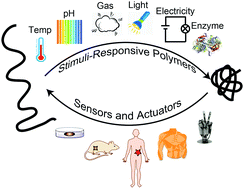Liang Hu, Qiang Zhang, Xue Li and Michael J. Serpe
Mater. Horiz., 2019,6, 1774-1793
DOI:
10.1039/C9MH00490D,
Review Article
The use of stimuli-responsive polymers in sensing technologies and for actuation has garnered tremendous interest over the past few decades. This is mainly due to the myriad responsivities that these polymers can possess, e.g., responsivity to temperature, pH, biomolecules, CO2, light, and electricity. As a result, these stimuli-responsive devices can be used to monitor human health and detect environmental analytes, for soft robotics and artificial muscles. In this review, we highlight state-of-the-art examples of the synthesis, and use of stimuli-responsive polymers in these fields that have been reported since 2016.
